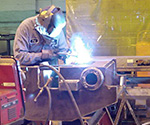*This post was written by John Fossey*
Reversing a Decade of Job Losses
What does a manufacturer do when it’s struggling with excessive costs? One of the most common reactions in recent years has been to pack up and move to another country or continent where it can bring its costs of production down.
And this is just what’s happening to a number of factories, except these are Asian plants moving production to the United States.
The Bureau of Statistics shows that close to six million manufacturing jobs were lost in the decade from 1999 to 2009, representing over one third of the sector’s workforce. But since 2010, this trend has turned around, recovering 550,000 jobs over the period, the first uptick since 1997.
Leading the Pack: Large Manufacturers Build New Facilities
The Wall Street Journal reports that Zhu Shanqing, chairman of Keer Group, is to spend $218 million in South Carolina to build a plant to spin yarn, adding 500 manufacturing jobs to the state’s economy. In another twist, China’s largest air conditioning manufacturer, Gree Electric Appliances, which manufacturers air conditioners sold in the US under a variety of different brands, is planning to build a plant in the US in 2014, although it wouldn’t say exactly where until the deal is sealed. And Hankook Tires, South Korea’s largest tiremaker, is planning to build a factory in Tennessee, to be in production by 2016, which will produce 11 million tires per year for the American market.
In a further strengthening of the trend, Chinese Lenovo Group, the world’s second largest manufacturer of personal computers, is planning to produce its ThinkPad laptop computers in North Carolina. Also, the world’s largest electronics contract manufacturer, Taiwan-based Foxconn Technology Group, which produces well-known brands under contract such as the BlackBerry, iPhone, Kindle and PlayStation, is to invest $30 million in a new robotics plant in Pennsylvania, with the possibility of a second plant in Arizona.
It’s Not Just Public Relations: the Myth of Cheap Asian Labor
Moves to reshore their manufacturing jobs have been driven in part by public pressure, for companies such as Apple, Hewlett-Packard and Walmart. However, the story isn’t only about labor costs. Walmart CEO Bill Simon told a recent manufacturing conference that in addition to rising Asian labor costs, oil and transportation costs are high and becoming increasingly uncertain. While in absolute terms Asian hourly wages are significantly less than the hourly wages of American manufacturing jobs, labor only represents about one tenth of total production costs, on average.
A series of reports from the Boston Consulting Group predicts that the US will reach cost parity with China by 2015 and that by the end of the decade as many as five million manufacturing jobs will be added. Chinese labor rates are rising 20% per year, according to the Manufacturer Alliance for Productivity and Innovation (MAPI), at the same time that the financial crisis has hit US wages.
How the American Trade Deficit Works in its Favor
The trade deficit that the United States has with China is having an unexpected result when it comes to exporting goods from the US to China. With transportation being one of the biggest expenses in overseas shipment, containers and cargo ships which leave for China empty after having arrived filled with Chinese-made goods allow American exporters to move their products to the Chinese market at a fraction of the cost of goods coming inbound. MAPI points out that American manufacturers actually have an advantage when it comes to shipping costs.
Transportation and Energy: a Key Reality
Shipping from China can be a major cost and headache which is set aside when manufacturing in America. Eliminating this factor from the supply chain can save both time and money. In a recent cost teardown, market researcher IHS found that Google is paying somewhat less overall to produce the Moto X smartphone in Texas, creating 2000 manufacturing jobs, than Samsung is paying to make its popular Galaxy S4 smartphone in Korea. Although the wages of manufacturing jobs are higher in Texas, they amount to only 5% of the total cost of the Moto X. With as little as four days lead time to deliver orders, Google is able to provide customized products to its customers while customers of its overseas competitors are waiting weeks for delivery.
Energy costs are falling rapidly in the US as shale gas is exploited, making the US a net exporter of energy, and oil finds are reducing or eliminating the need to import oil from shaky overseas suppliers. This translates into lower costs for electricity and transportation for American manufacturers, adding to the incentive to add manufacturing jobs here.
It’s Not Only About Costs: Quality, Proximity, Simplicity
China has long been seen as the place to manufacture to obtain a competitive advantage in terms of price. But as the price advantage is being eroded, manufacturers are becoming less tolerant of other problems that come with importing from the other side of the globe.
Quality has always been a problem. Rigid controls and inspections need to be conducted from a distance to ensure that products are produced with appropriate quality. A number of other problems have cropped up, such as worker exploitation, with quality of the production facility and methods coming into the public limelight.
Manufacturers are increasingly looking to eliminate these problems, with less of a cost incentive to work around them. When the manufacturing jobs are close at hand maintaining control over quality is relatively simple, in comparison to overseas production. Having production closer to the customers also has a significant effect in improved customer service. These factors can help boost sales, ultimately helping the bottom line.

